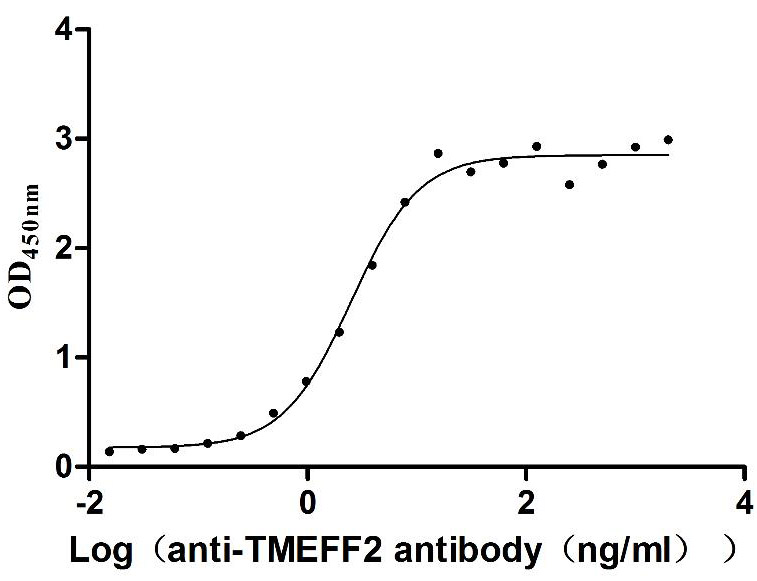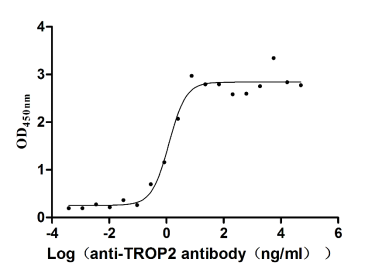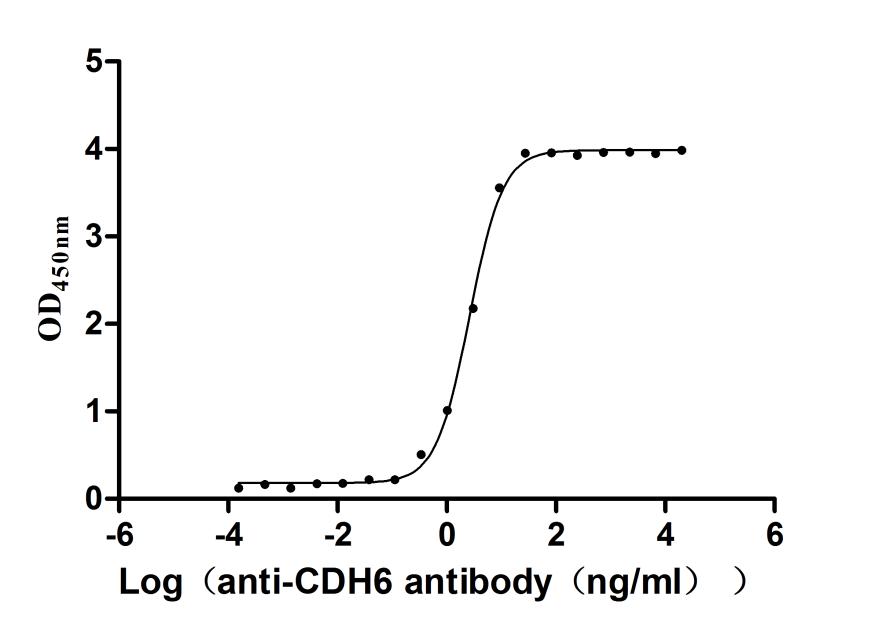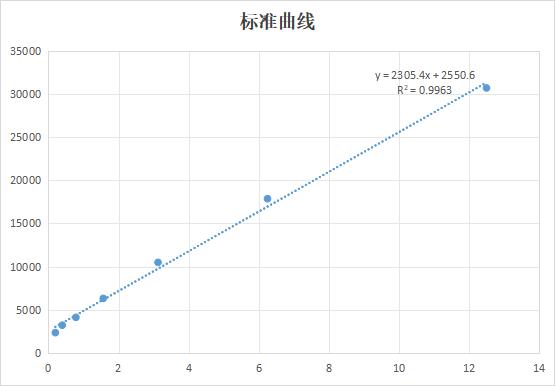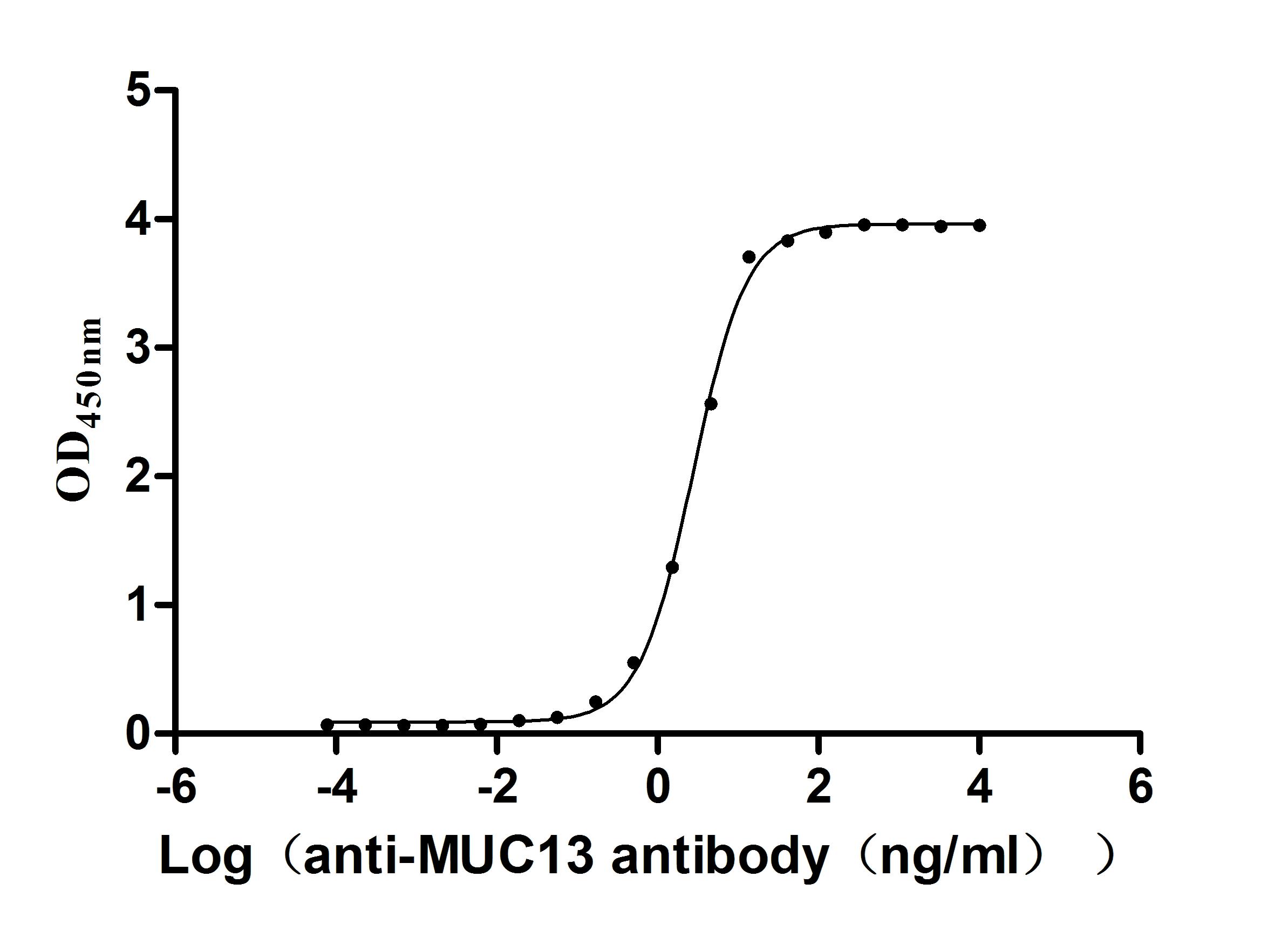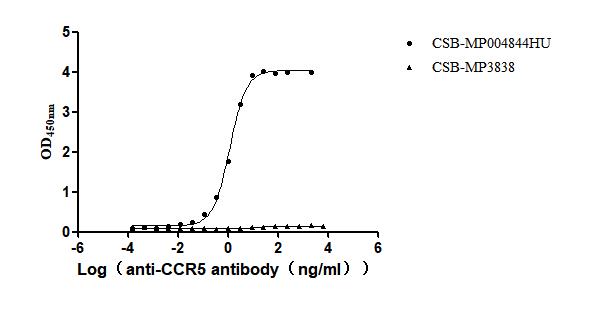Recombinant Mouse Tyrosine-protein phosphatase non-receptor type substrate 1 (Sirpa)
-
中文名稱:小鼠Sirpa重組蛋白
-
貨號:CSB-CF021334MO
-
規(guī)格:
-
來源:in vitro E.coli expression system
-
其他:
產(chǎn)品詳情
-
基因名:
-
Uniprot No.:
-
別名:Sirpa; Bit; Myd1; Ptpns1; Shps1; Sirp; Tyrosine-protein phosphatase non-receptor type substrate 1; SHP substrate 1; SHPS-1; Brain Ig-like molecule with tyrosine-based activation motifs; CD172 antigen-like family member A; Inhibitory receptor SHPS-1; MyD-1 antigen; Signal-regulatory protein alpha-1; Sirp-alpha-1; mSIRP-alpha1; p84; CD antigen CD172a
-
種屬:Mus musculus (Mouse)
-
蛋白長度:Full Length of Mature Protein
-
表達(dá)區(qū)域:32-513
-
氨基酸序列KELKVTQPEKSVSVAAGDSTVLNCTLTSLLPVGPIKWYRGVGQSRLLIYSFTGEHFPRVTNVSDATKRNNMDFSIRISNVTPEDAGTYYCVKFQKGPSEPDTEIQSGGGTEVYVLAKPSPPEVSGPADRGIPDQKVNFTCKSHGFSPRNITLKWFKDGQELHHLETTVNPSGKNVSYNISSTVRVVLNSMDVHSKVICEVAHITLDRSPLRGIANLSNFIRVSPTVKVTQQSPTSMNQVNLTCRAERFYPEDLQLIWLENGNVSRNDTPKNLTKNTDGTYNYTSLFLVNSSAHREDVVFTCQVKHDQQPAITRNHTVLGLAHSSDQGSMQTFPGNNATHNWNVFIGVGVACALLVVLLMAALYLLRIKQKKAKGSTSSTRLHEPEKNAREITQVQSLIQDTNDINDITYADLNLPKEKKPAPRAPEPNNHTEYASIETGKVPRPEDTLTYADLDMVHLSRAQPAPKPEPSFSEYASVQVQRK
Note: The complete sequence may include tag sequence, target protein sequence, linker sequence and extra sequence that is translated with the protein sequence for the purpose(s) of secretion, stability, solubility, etc.
If the exact amino acid sequence of this recombinant protein is critical to your application, please explicitly request the full and complete sequence of this protein before ordering. -
蛋白標(biāo)簽:N-terminal 10xHis-tagged
-
產(chǎn)品提供形式:Liquid or Lyophilized powder
Note: We will preferentially ship the format that we have in stock, however, if you have any special requirement for the format, please remark your requirement when placing the order, we will prepare according to your demand. -
緩沖液:Lyophilized from Tris/PBS-based buffer, 6% Trehalose, pH 8.0
-
儲存條件:Store at -20°C/-80°C upon receipt, aliquoting is necessary for mutiple use. Avoid repeated freeze-thaw cycles.
-
保質(zhì)期:The shelf life is related to many factors, storage state, buffer ingredients, storage temperature and the stability of the protein itself.
Generally, the shelf life of liquid form is 6 months at -20°C/-80°C. The shelf life of lyophilized form is 12 months at -20°C/-80°C. -
貨期:Basically, we can dispatch the products out in 1-3 working days after receiving your orders. Delivery time may differ from different purchasing way or location, please kindly consult your local distributors for specific delivery time.Note: All of our proteins are default shipped with normal blue ice packs, if you request to ship with dry ice, please communicate with us in advance and extra fees will be charged.
-
注意事項(xiàng):Repeated freezing and thawing is not recommended. Store working aliquots at 4°C for up to one week.
-
Datasheet & COA:Please contact us to get it.
相關(guān)產(chǎn)品
靶點(diǎn)詳情
-
功能:Immunoglobulin-like cell surface receptor for CD47. Acts as docking protein and induces translocation of PTPN6, PTPN11 and other binding partners from the cytosol to the plasma membrane. Supports adhesion of cerebellar neurons, neurite outgrowth and glial cell attachment. May play a key role in intracellular signaling during synaptogenesis and in synaptic function. Involved in the negative regulation of receptor tyrosine kinase-coupled cellular responses induced by cell adhesion, growth factors or insulin. Mediates negative regulation of phagocytosis, mast cell activation and dendritic cell activation. CD47 binding prevents maturation of immature dendritic cells and inhibits cytokine production by mature dendritic cells.
-
基因功能參考文獻(xiàn):
- Accumulation of SIRPalpha-inhibited macrophages in tumors favored tumor regression for 1-2 weeks, but donor macrophages quickly differentiated toward non-phagocytic, high-SIRPalpha TAMs. PMID: 28669759
- Anti-SIRPA antibody immunotherapy enhances neutrophil and macrophage antitumor activity. PMID: 29158380
- SIRPalpha-expressing dendritic cells regulate homeostasis of fibroblastic reticular cells via TNF receptor ligands in the adult mouse spleen. PMID: 29109283
- CCR7 deficiency results in apoptosis of Sirpa- dendritic cells, which is counterbalanced by expansion of immature Sirpa+ dendritic cells that efficiently induce Treg generation. PMID: 28978470
- Data provide evidence that SIRPalpha-mediated phagocytosis is not a major determinant in prion disease pathogenesis. PMID: 28545141
- TLR5 mediates CD172a(+) intestinal lamina propria dendritic cell induction of Th17 cells. PMID: 26907705
- a novel and opposite contribution of SIRPalpha signaling within non-hematopoietic and hematopoietic cells PMID: 26222253
- These findings demonstrate, for the first time, that SIRPalpha signaling can directly control phagocyte migration. PMID: 26057870
- SIRPalpha intrinsic to CD11c(+) dendritic cells is essential for homeostasis of conventional dendritic cells in the secondary lymphoid organs and skin. PMID: 25818708
- data identified SIRPalpha signaling in non-hematopoietic cells to play an important role in regulating the numbers and positioning MZB cell in the spleen PMID: 25817792
- Velcro" engineering of high affinity CD47 ectodomain as signal regulatory protein alpha (SIRPalpha) antagonists that enhance antibody-dependent cellular phagocytosis PMID: 25837251
- These data show a previously unappreciated and crucial role for SIRPalpha in the homeostasis of CD103(+) CD11b(+) DCs in the intestine PMID: 25236797
- These results suggest that thrombospondin-1 binding to SIRP-alpha on nonphagocytic cells activates NADPH oxidase, limits vasodilation, and promotes renal ischemia reperfusion injury. PMID: 24511121
- Studies suggest that the mouse strain effect on xenogeneic engraftment might be ascribed mainly to the binding affinity of strain-specific polymorphic SIRPA with human CD47. PMID: 24269920
- SIRPA plays a protective role in cardiac hypertrophy through negative regulation of the Toll-like receptor 4/nuclear factor-kappaB pathway. PMID: 24101669
- Signal regulatory protein alpha is associated with tumor-polarized macrophages phenotype switch and plays a pivotal role in tumor progression. PMID: 23504854
- SIRPalpha is involved in the regulation of podocyte structure and function as a filtration barrier under both physiological and pathological conditions. PMID: 23842779
- genetic induction of the expression of recipient CD47 on xenogeneic donor cells could provide inhibitory signals to recipient macrophages via SIPRalpha PMID: 23472187
- Ectodomain shedding of SIRPalpha is an activity-dependent trans-synaptic mechanism for the maturation of functional synapses. PMID: 24036914
- regulator of FcepsilonRI signaling in mast cells PMID: 23504624
- Downregulation of SHP-1 activity promotes corticospinal tract sprouting and functional recovery after brain injury. PMID: 23559001
- Sirpalpha is not exclusively immunoinhibitory, and illuminate previously unexplained observations implicating Skap2 and Sirpalpha in mouse models of inflammatory disease. PMID: 22976304
- Our data show that efficient human cell engraftment found in NOD-based models is mounted solely by their polymorphic Sirpa. PMID: 23293079
- CD47-SIRPalpha interactions and ITIM-dependent downstream signaling via SIRPalpha control the magnitude of the phagocyte respiratory burst by regulating the expression levels of gp91phox. PMID: 23022485
- Our findings demonstrate that B. pseudomallei evades macrophage intracellular killing by preventing the downregulation of SIRPalpha that results in the inhibition of gene expression downstream of the MyD88-independent pathway. PMID: 22988019
- thymic Sirpalpha(+) cDCs crucially contribute to a process of intrathymic tumor immune tolerance that involves CCR2 and CCL2 PMID: 22815949
- Thymic signal-regulatory protein (Sirp)alpha-positive conventional dendritic cells (cDCs) and CD8alpha-positive cDCs are equally competent in mediating presentation events to blood-borne hen egg white lysozyme by major histocompatibility class II molecules. PMID: 21178002
- SIRPalpha demonstrates an indispensable role for protective immunity in Salmonella infection. PMID: 22851710
- These results provide the first demonstration that SHPS-1 plays an important role in the oxidative stress and brain injury induced by acute cerebral ischemia PMID: 22671569
- Our data indicate that tyrosine phosphorylation of SIRPalpha is an immediate response of neurons in the brain to cold stress. PMID: 22468987
- SIRPalpha and Rho kinases interact in the cell migration of dendritic cells in skin. PMID: 22391241
- our results indicated that SIRPalpha/CD172a regulates eosinophil homeostasis PMID: 21775684
- The size of the T cell zone and number of resident CD4-positive T cells in the spleen are markedly reduced in the spleen of SIRPalpha mutant mice. PMID: 21632712
- The data thus suggest that SIRPalpha expressed on CD11c(+) LP cells is important for the production of IL-17 or IFN-gamma in the LP as well as for the development of colitis induced by IL-10 deficiency. PMID: 21040253
- SIRPalpha is important for homeostasis of LCs in the skin, as well as of migratory DCs in the LNs, but unlikely for migration of these cells from the skin to draining LNs. PMID: 20955735
- protein targeting (CD47-Fc fusion protein) protects from Th2-driven allergic airway inflammation PMID: 21108471
- We now show that the number of CD11c(high) dendritic cells (cDCs), in particular, that of CD8-CD4+ (CD4+) cDCs, is selectively reduced in secondary lymphoid tissues of mice expressing a mutant form of SIRPa that lacks the cytoplasmic region. PMID: 20682853
- These results suggest that SIRPalpha is indispensable for protective immunity against L. major by the induction of Th1 response. PMID: 20854790
- This identifies SHP-1-recruiting inhibitory immunoreceptor signal regulatory protein 1 (SIRPalpha) as a bona fide inhibitory receptor that regulates the bone-resorption activity. PMID: 19667119
- show regulated expression of SIRPa on Kupffer cell following L. donovani infection and propose that SIRPa-CD47 interactions regulate the activation threshold for invariant NKT cytokine production. PMID: 19877019
- SHP-1 is a critical factor in controlling virus replication in the CNS glia and virus-induced demyelination. PMID: 12134038
- SHPS-1 contributes to the survival of circulating platelets and down-regulates the macrophage phagocytic response PMID: 12167615
- role in inhibiting tumor necrosis factor-mediated apoptosis by activation of NF-kappa B PMID: 12446684
- role in IL-1beta- and TNFalpha-dependent signaling that leads to the activation of Erk 1/2 and Akt PMID: 12483539
- SHP-1 may be involved in the regulation of beta-catenin transcriptional function and in the negative control of intestinal epithelial cell proliferation PMID: 12571228
- substrate 1 protein plays an important role in the regulation of glial activation and proliferation in the ischemic CNS. PMID: 12742627
- SHP-1 may serve as a negative regulator of receptor activator of NF-kappa B ligand (RANKL)-induced intracellular signals and osteoclastogenesis in motheaten viable Mev/Mev mice. PMID: 14500659
- Data show that surfactant proteins-A and -D bind SIRPalpha through globular heads to block proinflammatory mediator production, while binding to their collagenous tails stimulates proinflammatory mediator production through binding to calreticulin. PMID: 14531999
- The interaction between SHPS-1 expressed in phagocytes and CD47 expressed in apoptotic cells works as a tethering step in phagocytosis. PMID: 14634079
- CD22 is an inhibitory coreceptor for B cell receptor (BCR) signaling. The inhibition is most likely mediated by activation of SHP-1. PMID: 14635051
顯示更多
收起更多
-
亞細(xì)胞定位:Membrane; Single-pass type I membrane protein.
-
組織特異性:Highly expressed in cerebral cortex, brain, spinal cord, cerebellum and spleen, and at much lower levels in kidney, thymus, heart, lung and liver. Within the cerebellum, highly expressed throughout the molecular layer, and in synaptic glomeruli in the gra
-
數(shù)據(jù)庫鏈接:
Most popular with customers
-
Recombinant Mouse Tyrosine-protein kinase Mer (Mertk), partial (Active)
Express system: Mammalian cell
Species: Mus musculus (Mouse)
-
Recombinant Mouse Claudin-18.2 (Cldn18.2)-VLPs (Active)
Express system: Mammalian cell
Species: Mus musculus (Mouse)
-
Recombinant Human Tomoregulin-2 (TMEFF2), partial (Active)
Express system: Mammalian cell
Species: Homo sapiens (Human)
-
Recombinant Human Tumor-associated calcium signal transducer 2 (TACSTD2), partial (Active)
Express system: Mammalian cell
Species: Homo sapiens (Human)
-
Recombinant Human Cadherin-6(CDH6),partial (Active)
Express system: Mammalian cell
Species: Homo sapiens (Human)
-
Recombinant Human Urokinase-type plasminogen activator(PLAU) (Active)
Express system: Mammalian cell
Species: Homo sapiens (Human)
-
Recombinant Human Mucin-13(MUC13),partial (Active)
Express system: yeast
Species: Homo sapiens (Human)
-
Recombinant Human C-C chemokine receptor type 5 (CCR5)-VLPs (Active)
Express system: Mammalian cell
Species: Homo sapiens (Human)


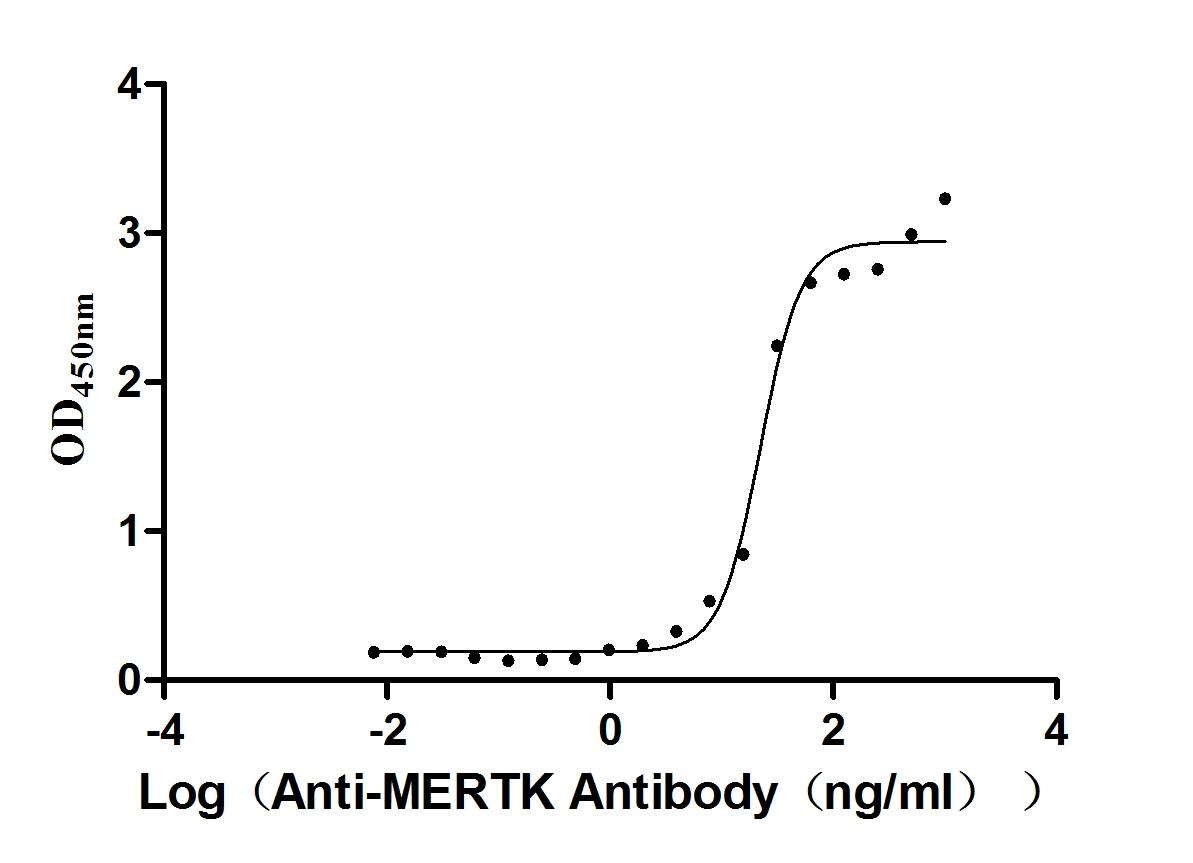
-AC1.jpg)
